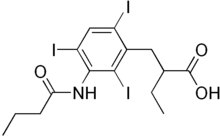Tyropanoic acid
Tyropanoic acid and its salt sodium tyropanoate are radiocontrast agents used in cholecystography (X-ray diagnosis of gallstones). Trade names include Bilopaque, Lumopaque, Tyropaque, and Bilopac.[1] The molecule contains three heavy iodine atoms which obstruct X-rays in the same way as the calcium in bones to produce a visible image. After injection it is rapidly excreted into the bile.[2]
 | |
 | |
| Names | |
|---|---|
| Preferred IUPAC name
2-[(3-Butanamido-2,4,6-triiodophenyl)methyl]butanoic acid | |
| Other names
2-(3-Butyramido-2,4,6-triiodobenzyl)butanoic acid 2-[[2,4,6-Triiodo-3-(1-oxobutylamino)phenyl]methyl]butanoic acid | |
| Identifiers | |
3D model (JSmol) |
|
| ChEMBL | |
| ChemSpider | |
| ECHA InfoCard | 100.043.976 |
| EC Number |
|
| KEGG | |
| MeSH | D014441 |
PubChem CID |
|
| UNII | |
CompTox Dashboard (EPA) |
|
| |
| |
| Properties | |
| C15H18I3NO3 | |
| Molar mass | 641.02 g/mol |
| Pharmacology | |
| V08AC09 (WHO) | |
Except where otherwise noted, data are given for materials in their standard state (at 25 °C [77 °F], 100 kPa). | |
| Infobox references | |
References
- "PubChem CID 5611".
- Felicetta, James V.; Green, William L.; Nelp, Wil B. (May 1980). "Inhibition of hepatic binding of thyroxine by cholecystographic agents". J. Clin. Invest. 65 (5): 1032–40. doi:10.1172/JCI109755. PMC 371433. PMID 7364937.
This article is issued from Wikipedia. The text is licensed under Creative Commons - Attribution - Sharealike. Additional terms may apply for the media files.